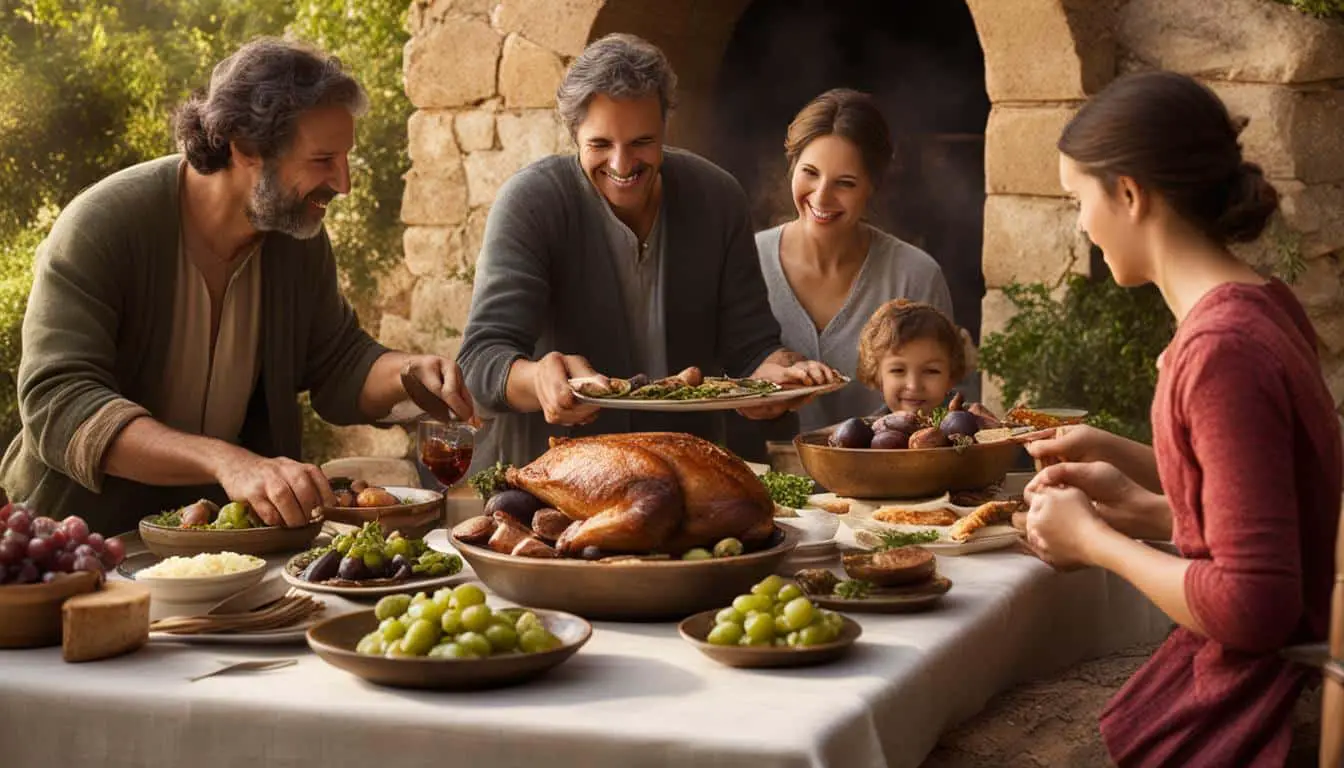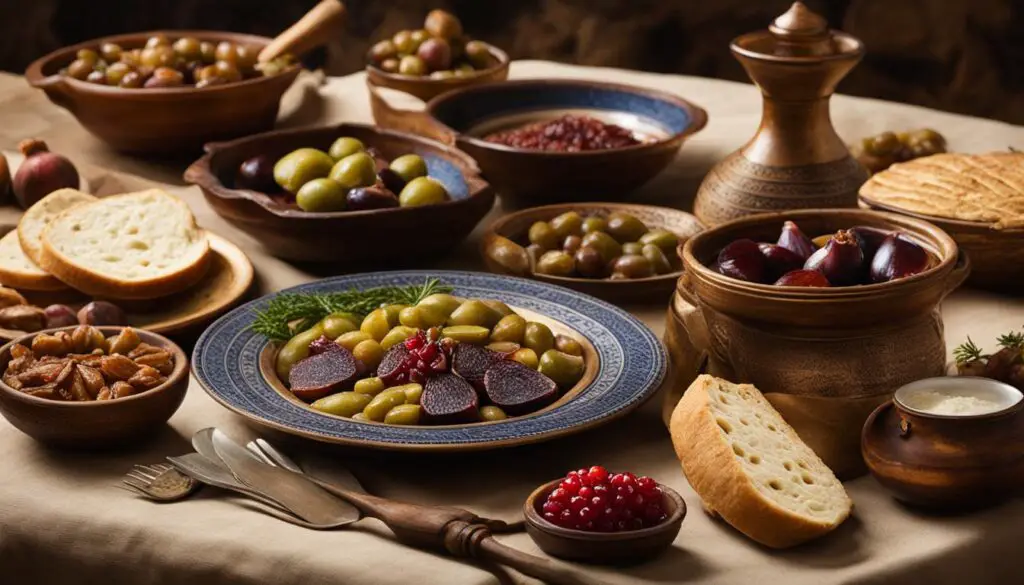
Food and Diet in Biblical Times: A Historical Look
Welcome to the first section of our article, where we delve into the intriguing world of food and diet in Biblical times. In this section, we will explore the culinary practices of the Israelites during the ancient Hebrew era, as well as examine the significance of food in the Bible and the meals of the Biblical era. Let’s take a fascinating journey back in time to discover the intriguing flavors and dietary customs of the ancient Israelites.
Key Takeaways:
- Ancient Israelite cuisine was based on the culinary practices of the Israelites during Biblical times.
- Their dietary staples included bread, wine, and olive oil, along with legumes, fruits and vegetables, dairy products, fish, and meat.
- The food adhered to the dietary restrictions and guidelines of Yahwism, Judaism, and Samaritanism.
- Primary sources of information include the Hebrew Bible, Dead Sea Scrolls, apocryphal works, and archaeological remains.
- Ancient Israelite food shared similarities with other Mediterranean cuisines at the time.
Dietary Staples in Ancient Israel
In the ancient Israelite diet, certain staples formed the foundation of their meals. These dietary staples included bread, wine, and olive oil, which were accompanied by a variety of other foods such as legumes, fruits and vegetables, dairy products, fish, and meat.
Bread, made from barley and wheat, was a staple food among the ancient Israelites. It was often toasted on stones heated directly on fire, resulting in a distinct flavor and aroma. Wine held an important place in their meals and was considered a symbol of joy and abundance. Olive oil, abundant in the region, was not only used for cooking but also for flavoring various dishes. Its versatility and richness enhanced the overall taste of the cuisine.
Legumes, such as lentils and beans, provided a valuable source of protein and nutrients in the ancient Israelite diet. Fruits and vegetables were also significant components, offering a wide range of flavors and textures. Dairy products, particularly milk from sheep and goats, were preferred over cow’s milk. Cheese was commonly made from these milks and added a savory element to dishes.
Fish, predominantly consumed in regions near the Sea of Galilee and the Mediterranean Sea, played a vital role in the ancient Israelite diet. It was often enjoyed alongside bread, creating a balanced meal. Meat, although considered a luxury and mainly consumed by the wealthy, included goat, lamb, and occasionally calf. Poultry, such as chickens, pigeons, and turtledoves, was relatively scarce in comparison. The inclusion of fish, meat, and poultry provided additional sources of protein and nutrients.
| Dietary Staples | Common Examples |
|---|---|
| Bread | Barley and wheat bread |
| Wine | Red and white wine |
| Olive Oil | Locally produced olive oil |
| Legumes | Lentils, beans |
| Fruits and Vegetables | Fig, date, grape, cucumber, onion |
| Dairy Products | Milk, cheese |
| Fish | Seafood from the Mediterranean Sea and Sea of Galilee |
| Meat | Goat, lamb, calf |
The dietary staples in ancient Israel provided sustenance and flavor to the Israelite people, reflecting their culinary preferences and available resources. These foods formed the core of their meals, accompanied by other ingredients that added depth and variety to their cuisine.
Other Food and Eating Practices in Ancient Israel
In addition to the dietary staples of bread, wine, and olive oil, the ancient Israelites enjoyed a wide variety of other foods. Honey, a common sweetener in biblical times, was used as a substitute for sugar. It was prized for its natural sweetness and versatility in culinary applications. Fruits such as figs, dates, and grapes were consumed fresh or dried, providing a source of natural sweetness and a burst of flavor. These fruits were not only enjoyed as a snack but also used in desserts and as ingredients in savory dishes.
Lentils, barley, and wheat were important grains in the ancient Israelite diet. These staples provided essential carbohydrates and nutrients, and they were used to make various types of bread, porridge, and other dishes. The protein-rich lentils were particularly valued for their nutritional benefits. Meat, although considered a luxury, was consumed by the wealthy and on special occasions. Goat, lamb, and occasionally calf were the preferred meats, reflecting the agricultural practices and cultural preferences of the time.
Poultry, including chickens, pigeons, and turtledoves, was relatively scarce in ancient Israel and therefore less commonly consumed compared to other meats. Fish, on the other hand, played an essential role in the diet, especially for communities living near the Sea of Galilee and the Mediterranean Sea. Freshwater and saltwater fish were readily available and often enjoyed alongside bread and other foods. Interestingly, locusts were also a part of the ancient Israelite diet. These insects were considered a delicacy and were consumed by some communities for their high protein content.
The ancient Israelites incorporated a variety of herbs and spices into their cooking to enhance the flavors of their dishes. Mustard, coriander, mint, garlic, and onions were commonly used to season and season the food. These aromatic ingredients added depth and complexity to the cuisine, transforming simple ingredients into delicious and satisfying meals. The use of herbs and spices also had cultural and symbolic significance, as they were often associated with religious rituals and practices.
This table provides a summarized overview of the various food and eating practices in ancient Israel:
| Food | Usage |
|---|---|
| Honey | Common sweetener |
| Figs, dates, grapes | Eaten fresh or dried |
| Lentils, barley, wheat | Staple grains |
| Meat | Luxury food, consumed on special occasions |
| Poultry | Relatively scarce |
| Fish | Significant part of the diet |
| Locusts | Considered a delicacy |
| Herbs and spices | Used for flavoring and seasoning |
These various foods and eating practices provide a glimpse into the rich culinary traditions of ancient Israel. They showcase the diverse range of ingredients and flavors that were enjoyed during biblical times. The food not only provided sustenance but also held cultural and religious significance, reflecting the values and beliefs of the Israelite society.

Conclusion
The food and diet in Biblical times provide us with valuable insights into the historical context and culinary traditions of the ancient Israelites. By examining the dietary practices of this ancient civilization, we can better understand their way of life and the cultural significance of food in their society.
Biblical foods and nutrition played a crucial role in the lives of the Israelites, as their diet was shaped by religious guidelines and the availability of local resources. Staples such as bread, wine, and olive oil formed the foundation of their meals, while a variety of other foods including legumes, fruits and vegetables, dairy products, fish, and meat added diversity and nutritional value.
Eating customs in the Bible were not only about sustenance but also played a central role in religious rituals and cultural customs. The use of honey as a sweetener, the importance of fruits like figs, dates, and grapes, and the inclusion of herbs and spices added depth and flavor to the ancient Israelite cuisine.
Ancient Jewish culinary traditions were closely intertwined with their way of life, and the historical food practices in the Bible shed light on the ancient Israelites’ relationship with food and the significance it held in their daily lives.
FAQ
What were the dietary staples in ancient Israel?
The dietary staples in ancient Israel included bread, wine, and olive oil, along with legumes, fruits and vegetables, dairy products, fish, and meat.
What were some other commonly consumed foods in ancient Israel?
Other commonly consumed foods in ancient Israel included honey as a sweetener, figs, dates, grapes, lentils, barley, wheat, and various herbs and spices.
What types of meat were consumed by the ancient Israelites?
The ancient Israelites consumed goat, lamb, and occasionally calf as meat, mainly by the wealthy. Poultry, such as chickens, pigeons, and turtledoves, was relatively scarce.
What role did fish play in the ancient Israelite diet?
Fish was a significant part of the ancient Israelite diet, especially in regions near the Sea of Galilee and the Mediterranean Sea. It was often consumed along with bread.
Did the ancient Israelites consume any unusual foods?
Yes, locusts were considered a delicacy and were eaten by the ancient Israelites.
What role did herbs and spices play in ancient Israelite cuisine?
Herbs and spices such as mustard, coriander, mint, garlic, and onions were used to season the food in ancient Israelite cuisine.
How do we know about the ancient Israelite diet?
The primary sources of information about the food of the ancient Israelites are the Hebrew Bible, the Dead Sea Scrolls, apocryphal works, and other texts. Archaeological remains, such as pottery, animal bones, and paleobotanical remains, have also provided valuable insights into the ancient Israelite diet.
